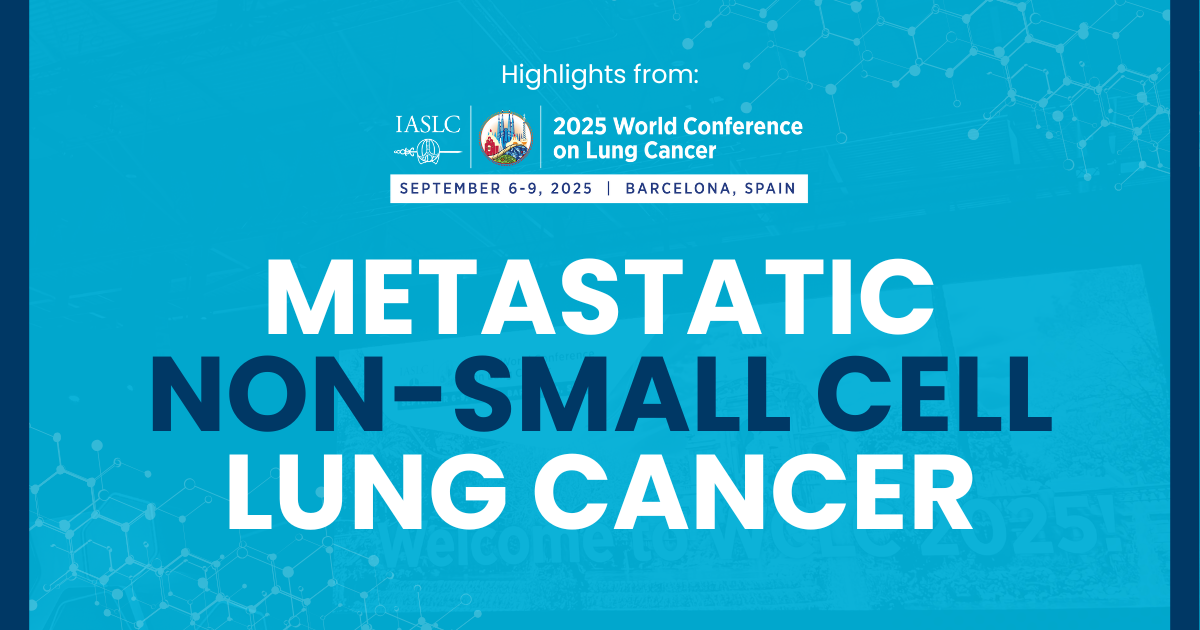For people with advanced or metastatic non-small cell lung cancer (NSCLC), the treatment landscape has changed dramatically in recent years. Researchers are learning how to optimize existing therapies and are exploring entirely new treatment approaches. At the 2025 World Conference on Lung Cancer (WCLC), several studies highlighted progress in treating newly diagnosed individuals as well as those who need new options after standard therapies stop working.
Combining Chemotherapy and Targeted Therapy to Treat EGFR-positive Lung Cancer
One of the most anticipated studies at WCLC was the phase 3 FLAURA2 trial, which studied the benefit of adding chemotherapy to osimertinib (a targeted drug for tumors with EGFR mutations) in the first-line setting. The results demonstrated that those who received the combination lived an average of 47.5 months compared to 37.6 months for those who received osimertinib alone. While the combination may not be optimal for every patient, these results suggest that adding chemotherapy up front can extend survival for some.
What’s Next After Osimertinib Stops Working?
Another important question for people with EGFR-positive lung cancer is how to treat cancer once it progresses on osimertinib. The COMPEL study looked at adding chemotherapy while continuing osimertinib, rather than switching entirely to chemotherapy alone. This phase 3 trial showed that people who stayed on osimertinib along with chemotherapy had a longer progression-free survival of 8.4 months and fewer new brain metastases compared to 4.4 months in patients given chemotherapy plus a placebo. The findings suggest that osimertinib may serve as a reliable backbone therapy (a treatment that can be continued and combined with other therapies) even after initial resistance develops, allowing those with EGFR-positive lung cancer to benefit from multiple lines of treatment over time.
KRAS G12C Targeted Treatment Poised to Move Into First-Line Use
People who are newly diagnosed with KRAS G12C-positive lung cancer have limited options for initial treatment. Researchers looked at data from two studies -- the phase 1 LOXO-RAS-2001 study and the phase 3 SUNRAY-01 study – that tested the use of olomorasib, a highly specific KRAS G12C inhibitor, combined with chemoimmunotherapy as a first-line treatment for people with advanced KRAS G12C-positive NSCLC. More than half of patients on this regimen (61%) had their tumors shrink or disappear, and 90% benefited (disease control rate) from this combination. This promising work continues in the phase 3 SUNRAY-01 clinical trial and offers hope for a new treatment option for newly diagnosed people with KRAS G12C-positive lung cancer.
A Next-Generation Treatment for ROS1-positive Lung Cancer
Those with tumors carrying a ROS1 biomarker may soon have another promising treatment option. The phase1/2 ARROS-1 trial tested zidesamtinib, an investigational ROS1-inhibitor designed to work in the brain and avoid side effects caused by blocking other important protein functions. In patients who had not received a prior ROS1 therapy, 89% had their tumors shrink or disappear (response rate). In those previously treated with ROS1 therapies, the response rate was 44%. Importantly, zidesamtinib has shown activity against G2032R, a known acquired resistance mutation, suggesting zidesamtinib is a promising next-generation treatment to keep an eye on.
Exploring Viral Immunotherapy for Tumors Resistant to Checkpoint Inhibitors
For people with lung cancer that no longer responds to immune checkpoint inhibitors, new strategies are urgently needed. One novel treatment approach being studied is CAN-2409, a viral immunotherapy that uses a modified adenovirus to deliver a gene (HSV-tk) into tumor cells. In a phase 2a trial, CAN-2409 was combined with valacyclovir (an antiviral drug commonly used to treat herpes infections) and continued checkpoint inhibition in those with unresectable stage III or IV NSCLC who had already progressed on PD-1 or PD-L1 inhibitors. Across all patients, the average overall survival was 24.5 months with 37% of patients alive after two years. These findings suggest viral immunotherapy may emerge as an exciting new approach to lung cancer treatment.
Looking Ahead
The studies presented at WCLC show tremendous progress in treating metastatic NSCLC. Researchers continue to push the boundaries of what is possible for patients by enhancing the benefit of existing therapies, finding new drugs that overcome resistance, and exploring cutting-edge immunotherapy. Whatever the approach, the ultimate goal remains the same: to extend survival and improve quality of life for everyone facing this disease.
Make sure to read all of our 2025 World Conference on Lung Cancer coverage:

